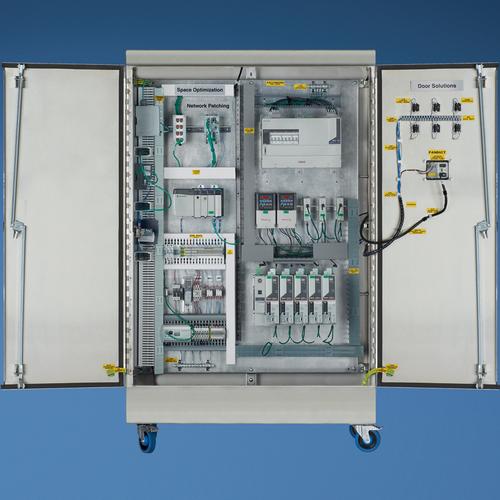March 10, 2015

Unused space. Energy distribution. Thermal management. When it comes to the manufacturing floor, space is at a premium and the drive to reduce costs by fitting panels into tight spaces while complying with safety and regulatory requirements can be challenging. While smaller panels are an option, they present other challenges such as noise mitigation, adhering to minimum separation requirements for electronic components, and codes and standards compliance.
What is a design engineer to do?
When designing a control panel, you have enough worries and responsibilities and should not be concerned with additional design challenges. The following tips can help achieve design flexibility and regulatory compliance while bringing you peace of mind.
Look closely and you'll find unused space
An area that is hardly used in the control panel is the space between the enclosure door and the components mounted to the sub-panel in the rear of the enclosure, sometimes referred to as the three-dimensional (3D) space. Using products that tap into this 3D space can save up to 40% of the space on a sub-panel, leading to a smaller control panel design or maximizing an existing panel's effectiveness. For example, some wiring duct products allow a DIN rail to be mounted on the duct itself rather than on the control panel, allowing the user to reclaim or repurpose valuable control panel real estate.
MORE FROM DESIGN NEWS: Design Decisions: Understanding the Value of Integrated System Design
Don't cut corners
Along with the 3D space, corners are another area inside the control panel that go unused or underutilized in most traditional panel layouts. Products that tap into this unused space, such as wiring duct designed to fit in corners, can provide an excellent transition from rear sub-panels to side sub-panels and hold the potential to save up to 12% of space on the sub-panels and decrease the enclosure footprint by 18%.
Noise mitigation products can help space savings
Noise mitigation products are not typically space-saving tools. However, there are products that bring together wiring normally separated by at least six inches of air space. This creates an effective EMI barrier, reclaiming crucial inches of real estate. Some wiring ducts can incorporate a metal noise barrier to help achieve the equivalent of those six inches of air space, allowing the control panel layout to become more compact.
MORE FROM DESIGN NEWS: Energy Efficiency Drives Motor Control Design Trends
Maximize energy distribution
Panel design optimization is important to minimize equipment size, which affects the protective enclosure containing the sub-panel, and represents the outer envelope of the power distribution and control housing in equipment design. The approach for introducing electrical power into and distributed throughout an enclosure also impacts its size. Traditional wiring methods use older components such as power distribution blocks (PDB) where large conductors enter one side of the PDB and small conductors exit the other side. PDB requires significant labor to install and anchor a power control component to a specific location in the panel design, leaving little room for variation or modification.

Conversely, modular busbar systems can distribute power of less than 150A to well over 1,800A at system voltages of up to 600V, and are relevant for virtually all power distribution and control panels in machine design today. Modular busbar systems, through their space-saving strategies, can deliver upwards of 25% space savings in traditional motor control applications, variable frequency drive applications, and power distribution panels for industrial equipment. This space savings can often allow the designer to select the next smaller enclosure.
Thermal demands
Saving space in a control panel often means mounting active heat-generating devices in close proximity with one another, and putting them into a smaller, more compact enclosure. While desirable for saving space, it creates a problem for heat dissipation because there are more heat-generating devices in a smaller enclosed space.
Understanding the thermal needs of a control panel is a key component to control panel design. There are several levels of thermal management solutions, depending on the amount of heat being generated inside the panel, the environment surrounding the control panel, and the type and size of the enclosure used for the control panel design. There are also several products that can help manage thermal demands, including small footprint air conditioners, thermoelectric coolers, and compact cooling fans. These products, when used in the right application can allow the designer to fit more heat-generating devices into a smaller space.
It is easy for design engineers to get overwhelmed by the tremendous demands encountered when meeting space requirements. Follow these tips and you will have control of your space in no time.
James Brasch is associate product manager for Panduit Corp.
About the Author(s)
You May Also Like





